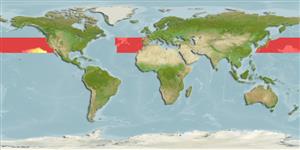>
Argentiniformes (Marine smelts) >
Opisthoproctidae (Barreleyes or spookfishes)
Etymology: Dolichopteryx: Greek, dolichos = long + Greek, pteryx, = wing, fin (Ref. 45335); longipes: longipes refers to the long pelvics (Ref. 4525).
More on author: Vaillant.
Environment: milieu / climate zone / depth range / distribution range
Ecología
marino batipelágico; oceanodromo (Ref. 51243); rango de profundidad 500 - 2400 m (Ref. 74511). Deep-water; 45°N - 27°N, 180°W - 180°E
Probably worldwide in temperate and tropical waters. Eastern Pacific: California Current region (Ref. 35626). South China Sea (Ref.74511).
Tamaño / Peso / Age
Maturity: Lm ? range ? - ? cm
Max length : 18.0 cm SL macho / no sexado; (Ref. 6542)
Short description
Morfología | Morfometría
Radios blandos dorsales (total): 10-11; Radios blandos anales: 8 - 9; Vértebra: 46 - 47. Body deep. Short pectoral fins, long ventral fins. Relatively large head and absence of ventral light organs. Line of dark chromatophores along the body below lateral line (Ref. 37473).
Oceanic and mesopelagic species (Ref. 6686). Taken regularly at depths shallower than 458 m, with scientific deep-sea fishing gear. Feed mainly on small crustaceans, particularly copepods (Ref. 4525). Oviparous, with planktonic larvae (Ref. 35626) and eggs (Ref. 6686). Paedomorphic (Ref. 35626).
Life cycle and mating behavior
Madurez | Reproducción | Puesta | Huevos | Fecundidad | Larva
Quéro, J.-C., 1990. Opisthroproctidae. p. 241-243. In J.C. Quero, J.C. Hureau, C. Karrer, A. Post and L. Saldanha (eds.) Check-list of the fishes of the eastern tropical Atlantic (CLOFETA). JNICT, Lisbon; SEI, Paris; and UNESCO, Paris. Vol. 1. (Ref. 6542)
IUCN Red List Status (Ref. 130435)
Threat to humans
Harmless
Human uses
Más información
ReferenciasAcuiculturaPerfil de acuiculturaRazasGenéticaElectrophoresesheritabilidadEnfermedadesProcesamientoNutrientsMass conversion
ColaboradoresImágenesStamps, Coins Misc.SonidosCiguateraVelocidadTipo de nataciónSuperficie branquialOtolitosCerebrosVisión
Herramientas
Special reports
Download XML
Fuentes de Internet
Estimates based on models
Preferred temperature (Ref.
123201): 3 - 5, mean 4.1 °C (based on 66 cells).
Phylogenetic diversity index (Ref.
82804): PD
50 = 0.5020 [Uniqueness, from 0.5 = low to 2.0 = high].
Bayesian length-weight: a=0.00437 (0.00170 - 0.01121), b=3.10 (2.88 - 3.32), in cm total length, based on LWR estimates for this (Sub)family-body shape (Ref.
93245).
Nivel trófico (Ref.
69278): 3.0 ±0.00 se; based on food items.
Generation time: 2.2 ( na - na) years. Estimated as median ln(3)/K based on 1
growth studies.
Resiliencia (Ref.
120179): Medio, población duplicada en un tiempo mínimo de 1.4-4.4 años (Assuming tmax>3).
Fishing Vulnerability (Ref.
59153): Low to moderate vulnerability (25 of 100).
